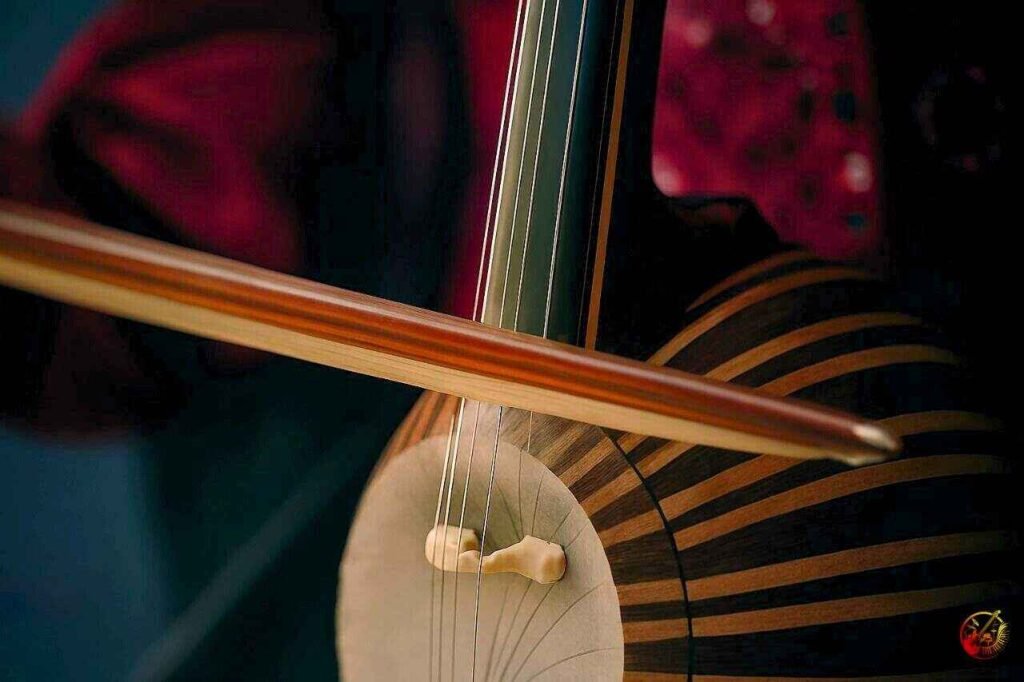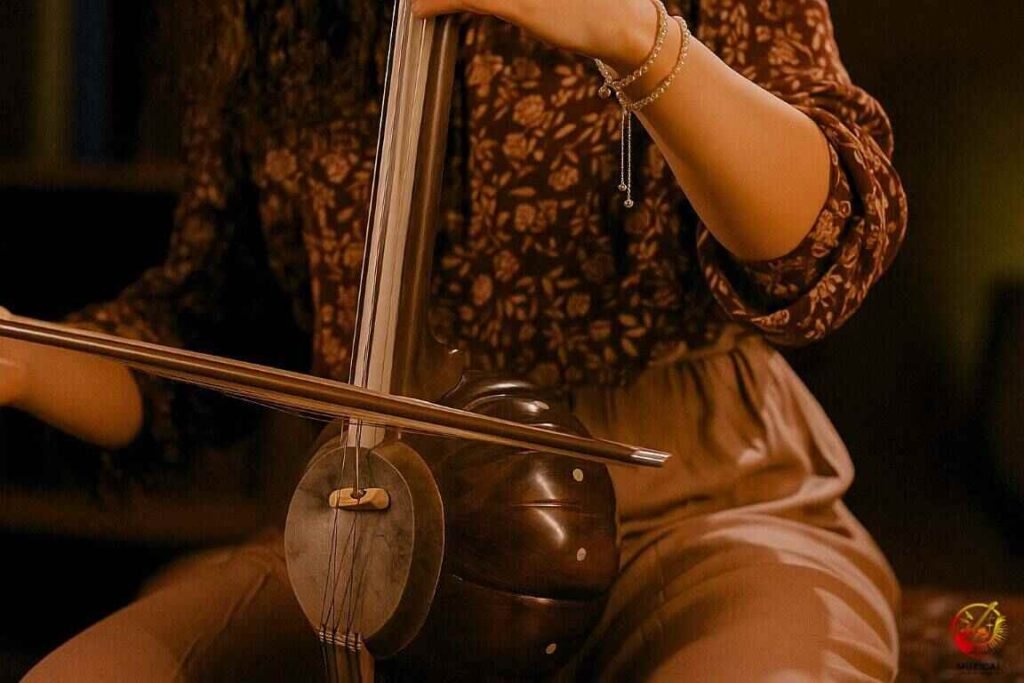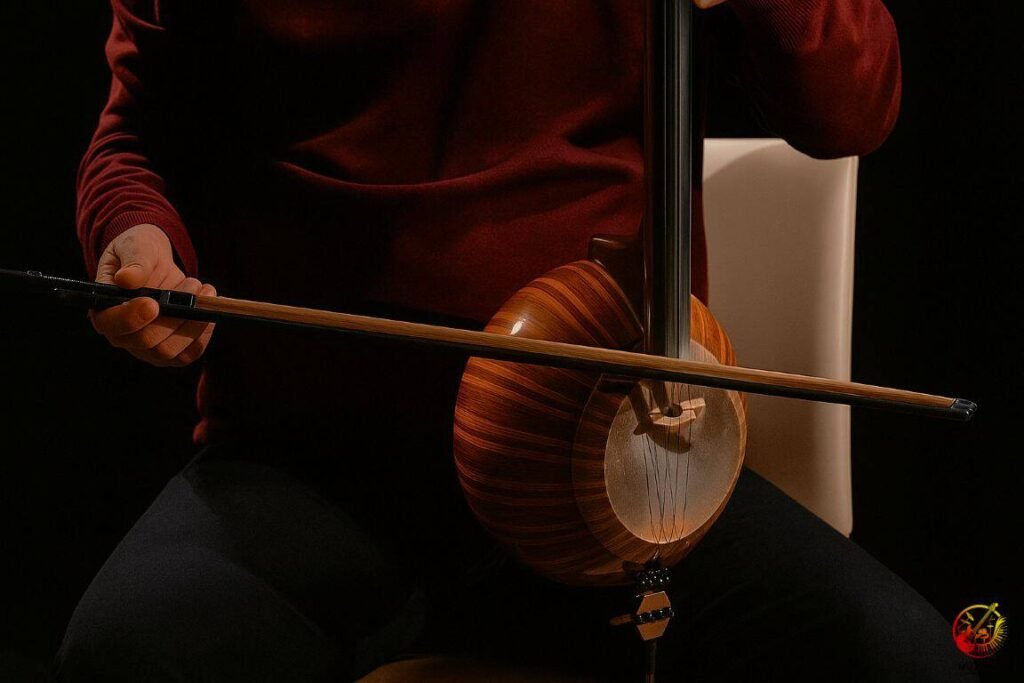How to Play Low Notes on Kamancheh
Learning how to play low notes on Kamancheh is often a big hurdle for players. Many students find their bottom notes sound scratchy, weak, or just plain muddy.
The secret to getting a deep, rich sound isn’t about using brute force; it’s about understanding the right mix of technique, pressure, and connection with your instrument.
This guide will break down the simple, practical steps you can take to improve your bowing, left hand technique, and overall approach.
You’ll learn how to turn those unclear low notes into the powerful, emotional foundation of your music, mastering your Kamancheh’s full voice from top to bottom.
What’s the Right Way to Bow for Low Notes?

This is the number one question I get. You’d think that getting a big, low sound means you have to press down hard with the bow. It seems to make sense, but that’s actually what causes most problems.
Pressing too hard will choke the string and give you a scratchy, awful sound instead of a warm, full one. The real magic is in your bow weight and speed.
Instead of pushing, just let the natural weight of your arm do the work. Let the bow sink into the string. Your real focus should be on how fast you move the bow. A slower, steadier bow stroke gives the thick low strings enough time to really start vibrating. If you pull the bow too fast, you’ll only skim the surface and get a thin sound. It’s like pushing a heavy car; one slow, strong push works way better than a bunch of fast, weak shoves.
Also, try bowing a little closer to the bridge. This spot helps bring out more of the string’s character, adding richness to the main note. Practice playing long, slow, even notes. Really listen to how the sound starts and grows.
Paying close attention with your ear is just as important as the physical movement. This is a key part of learning how to play low notes on Kamancheh effectively.
Expert Insight: Here’s a great exercise. Place your bow on the lowest string without making a sound and just feel your arm’s weight on it. Now, start a down bow so slowly you can barely hear it. Gently speed up until you find that perfect point where the string sings with a full, clear voice. This teaches you how to get the best sound with the least effort.
How Does My Left Hand Affect the Low Notes?

Your left hand is just as important as your bow arm for getting clean low notes. While the bow makes the sound, your left hand chooses the pitch. A big mistake is using a light touch on the thick low strings, like you might on the higher, thinner ones. Those thick strings need a firmer, more exact touch from your fingertips to make a clean, in tune note.
Think about it: a thicker string is heavier and needs more direct pressure to stop it in the right place. If your finger is too light, the string won’t be fully stopped. This causes a fuzzy, unclear pitch or buzzing sounds. You need to use the fleshy pad of your fingertip, placing it down with purpose.
Also, the spaces between notes are bigger on the lower part of the strings. This means your fingers have to stretch a bit more to be in tune, a skill known as intonation. This is where practice and ear training are so important.
Play slow scales on your bottom two strings, using a tuner at first to guide you. Soon, your hand will learn the feel of the distances. The goal is to be firm and confident, not tense. Staying relaxed helps you play longer and more smoothly.
Fixing Common Left-Hand Problems
| Problem | What Might Be Happening | How to Fix It |
|---|---|---|
| Buzzing or “Sizzling” Sound | Finger pressure is too light; finger is lying too flat. | Press down more firmly with the very tip of your finger. Make sure your finger is curved to create a clean stopping point. |
| Muddy or Unclear Pitch | Your finger placement is slightly off the correct spot for the note. | Practice with a tuner. Play a note, look at the tuner, adjust your finger, and hold it. Repeat this until it feels natural. |
| Fingers Feel Slow or Clumsy | Too much tension in your hand, wrist, or arm. | Keep your wrist straight and your thumb loose behind the neck. Practice slowly placing and lifting your fingers without even using the bow. |
Will Different Strings Help Me Play Low Notes?
Yes, for sure! The strings you use can make a huge difference in how to play low notes on Kamancheh. The thickest two strings do most of the heavy lifting for the bass register, and not all are created equal. If you’re having a tough time, the first thing to check is your strings.
Are they old and worn out? Over time, dirt and oil from your hands get into the string windings and make them sound dead. An old string just can’t vibrate the way it needs to, which makes getting a good low tone almost impossible. Sometimes, the easiest fix is just putting on a fresh set of strings.
When you buy new strings, think about gauge (how thick they are) and tension. Thicker strings can give a fuller, deeper sound but will also be harder to press down with your left hand. It’s a trade off.
Some players, like the famous master Kayhan Kalhor, try different brands to find the perfect match for their specific instrument. There’s no single “best” string; it’s all about what feels and sounds right to you and your instrument. Talking to a luthier (an instrument maker) can also give you great ideas.
Comparing String Types for Kamancheh
| String Material | What They’re Made Of | How They Sound | Good to Know |
|---|---|---|---|
| Gut Core | Sheep gut, often wound with silver. | The traditional sound: warm, rich, and very complex. | Can go out of tune easily with weather changes. |
| Synthetic Core | Nylon or other man-made fibers with a metal winding. | A good mix: warm like gut but stable and clear. | Very reliable and popular with modern players. |
| Steel Core | Solid steel wire with a metal winding. | Bright, loud, and powerful. Responds very quickly. | Can sound a bit sharp or metallic on some instruments. |
How Important is My Posture for a Good Sound?

How you sit is the base for your entire sound. If you’re slouched over or tense, you’re holding back your instrument’s true voice, which is a big problem when figuring out how to play low notes on Kamancheh. A powerful, open sound starts with a relaxed and straight body.
Think of your body as a speaker. The vibrations from your Kamancheh travel down the spike, into your leg, and through your whole body. If you’re tense, you’re basically muffling your own sound. Sit up straight but not stiff. Let your shoulders relax and drop away from your ears. This open posture gives your bowing arm total freedom of movement.
That freedom is key for sound production in the low register. Tension in your shoulder or wrist will stop you from drawing the smooth, heavy, and slow bow stroke you need. The power for a big sound comes from your back and arm, not just your wrist.
If your arm feels tired or your sound gets shaky on long notes, check your body. Are you holding your breath? Are your shoulders tight? Shake it out, breathe, and reset. It’s amazing how much your warm tone can improve just by relaxing.
Final Thoughts: Finding Your Kamancheh’s True Voice
In the end, learning how to play low notes on Kamancheh is all about smart technique, not muscle. It’s about letting go of the need to push hard and instead trusting in the right bow speed, solid finger pressure, and a relaxed body. When you focus on these details, you give your instrument the chance to sing with its full, deep voice.
Spend time every day just playing long, slow notes on your bottom strings. Record yourself and listen back. Is the sound clear? Is the pitch steady? This is how you’ll make real progress.
Once you’ve unlocked that rich lower register, you’ll be able to express so much more emotion in your music. Mastering how to play low notes on Kamancheh opens up a whole new world of beautiful melodies.
FAQ: How to Play Low Notes on Kamancheh
1. Why do my low notes on the Kamancheh sound scratchy?
A scratchy sound on the low notes is almost always caused by too much bow pressure and not enough bow speed. Instead of pressing down hard, try letting the natural weight of your arm rest on the string. Focus on pulling the bow more slowly and smoothly to allow the thick string to vibrate fully, which is a key part of learning how to play low notes on Kamancheh with a clear, warm tone.
2. How can I improve my intonation on the Kamancheh’s lower strings?
Improving intonation on the lower strings requires firm, precise finger placement and dedicated ear training. The notes are spaced farther apart, so you need to press down confidently with the pads of your fingertips. Practice slow scales with a tuner to build muscle memory and train your ear to recognize the correct pitches in the lower register.
3. What are the best strings for a deep Kamancheh sound?
There’s no single “best” string, as it depends on your instrument and preference. However, synthetic core strings (like Perlon) offer a great balance of warmth and stability, making them a popular choice. For a more traditional and complex sound, gut core strings are excellent but require more maintenance. If you’re struggling, simply replacing old, worn-out strings can make a huge difference.
4. How do I stop my fingers from buzzing on the low strings?
Buzzing is usually a sign of insufficient finger pressure or incorrect placement. Make sure you are pressing down firmly with the very tip of your finger, not the flat part. Your finger should be curved to create a clean, definite stopping point on the string. This ensures the string vibrates cleanly without rattling against your finger.
5. Does my posture really affect my Kamancheh’s sound?
Yes, absolutely. A relaxed, upright posture is the foundation of good sound production. Slouching or holding tension in your shoulders restricts your bowing arm and muffles the instrument’s resonance. Sitting straight allows your entire body to act as a resonator and gives your arm the freedom needed for the controlled, heavy strokes required for low notes.
6. What is the most important technique for playing low notes on Kamancheh?
The single most important technique is controlling your bow speed. While finger pressure and posture are crucial, the ability to draw a slow, steady, and weighted bow stroke is what truly activates the lower strings. Mastering this skill is fundamental to learning how to play low notes on Kamancheh with a rich and powerful voice.
7. How often should I change my Kamancheh strings?
For active players, it’s a good idea to change your strings every 3-6 months. Over time, strings accumulate dirt and lose their ability to vibrate freely, which particularly affects the richness of the low notes. If your low strings sound dull or dead, it’s definitely time for a new set.
